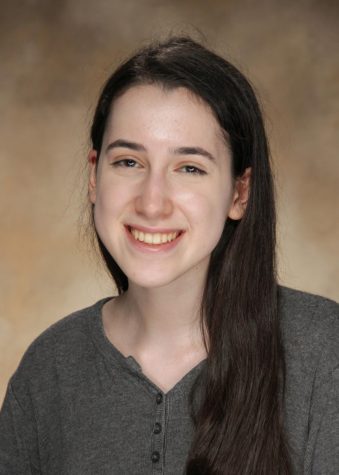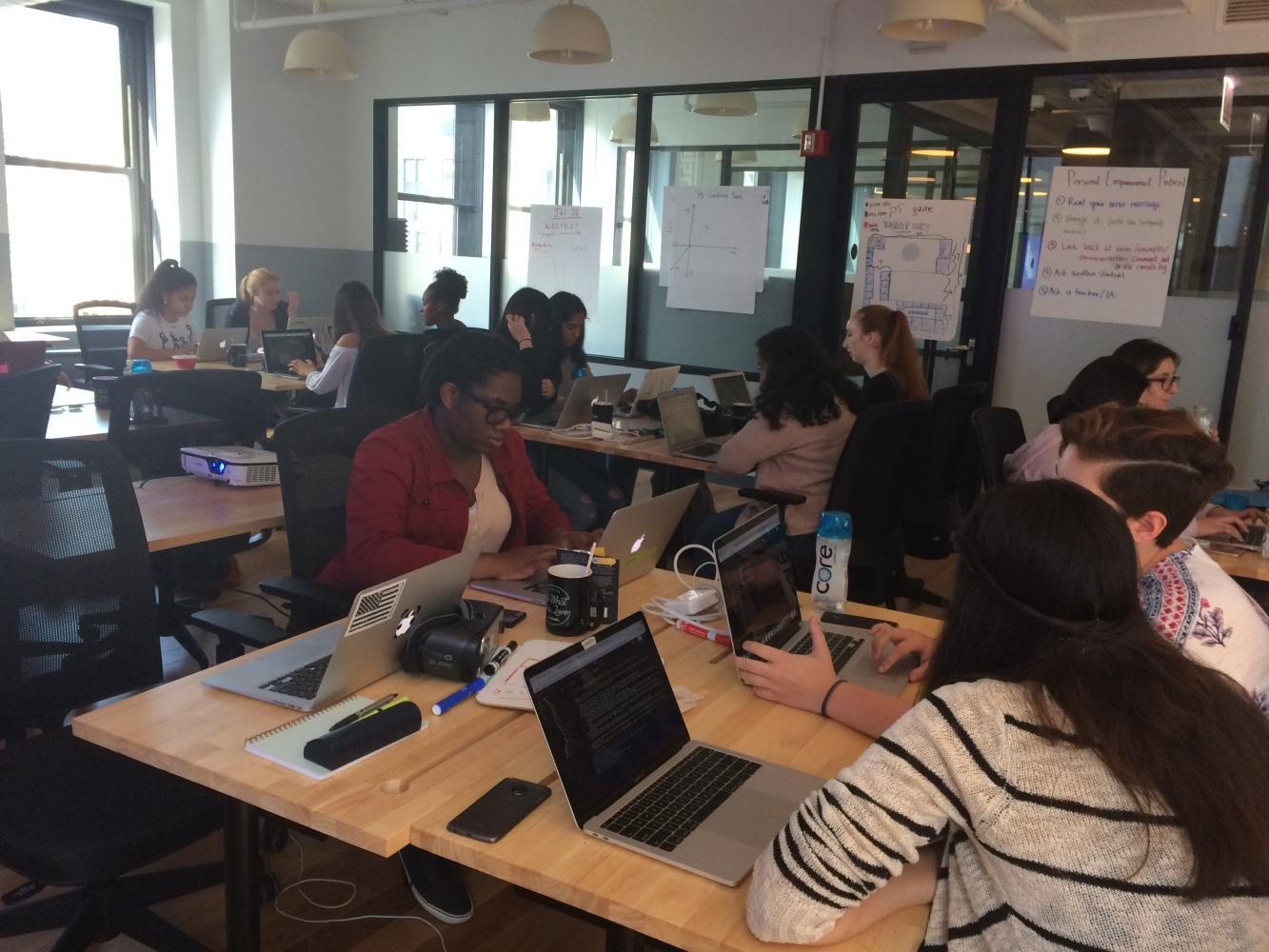
Code to success: Koding with Klossy empowers young women in computer science
August 30, 2017
Supermodel Karlie Kloss calls coding a “superpower,” but I wasn’t sure I truly understood that until I attended the summer program she founded, Kode with Klossy.
Although the program has offered girls scholarships in coding since 2015, the Kode with Klossy 2-week program as it exists today began last year. In the summer of 2016, there were 3 “Level 1” camps: one in St. Louis, one in New York and one in Los Angeles. The program was offered to teenage girls who had little to no prior coding experience, and primarily taught the scholars Ruby, a relatively simple programming language.
This year, however, the program expanded to two levels and more locations. Since I had taken an introductory computer science class at school, I chose to attend the Level 2 class in Chicago. The class was diverse — girls were from around the country and had a wide range of coding backgrounds.
My prior coding experience was in a different programming language than what would be taught in the class, so I was a bit nervous going in. There was so much hype about the program, too; the email I received the night before camp contained a video from Karlie Kloss in which she told us how excited she was for what we would accomplish and how she thought that we would surprise ourselves.
My first day in the WeWork National Building, I was told many times how, more than anything, Kode with Klossy is the amazing program that it is due to the community. The empowering environment that I was about to find in the camps exists not only because of the atmosphere of the camps but also because everyone who attends the camps truly loves what she is doing. The people I met persevered and stuck with their code through numerous errors, and after a grueling eight hour day, some would even continue coding at home.
I entered the camp during what can only be described as a bizarre scenario. There were five girls, who, when another one standing in an outside circle yelled out a vegetable, pretended to be that vegetable. This was a “vegetable-off,” a strange but iconic Kode with Klossy way of determining the winner of a game that goes on for too long or results in a tie.
Improv games were a staple of the camp; our lead instructor Taylor told us from the beginning that their purpose was three-fold, one to break up the camp and the hours of focus on coding, one to have fun and the other to help us continue to break out of our comfort zones in whichever way possible.
That same day, we were also introduced to the way that Kode with Klossy categorizes their learning process. They describe three “zones”: a comfort zone, a learning zone and a panic zone. While they hoped we would spend most of the camp on the border between the panic and learning zones — where you at least know the questions you need to ask to get the task done — they acknowledged that we would occasionally dip into both the comfort and panic zones.
What I found remarkable about the camps was how helpful and receptive everyone was. Our two TAs and two instructors would continuously walk around the room checking in on how everyone was doing and they would be more than willing to answer any question that you had, or, if the problem required more work, pull up a chair and work through it with you.
Kode with Klossy also relies heavily on feedback. Every afternoon, we filled out forms to assess how our days went, and every morning the instructors addressed the forms and corrected the camp per the suggestions. Due to feedback, the Los Angeles version of Level 2, the first one of the year, contained a very different curriculum from the ones at the later camps, because the instructors had shaped the camps due to feedback. That level of attention on the campers and how they feel about the camp is also what made my experience so amazing.
The class was mainly conducted on popular coding resources Cloud9, an online location to type and test all your code, and Github, where we could publish our code. We also used Slack to communicate and share documents, projects, and code from the lessons.
In the course, we were also taught to think more like programmers — to look up the documentation, or resources, for different programming languages before asking questions, because maybe the information we needed was listed online somewhere.
The structure of the day was a lecture-lab format. It began with a “code-along,” in which we followed the instructor through an activity that introduced us to a new programming language or library. After the “lecture,” we broke off into randomly assigned partner groups and solved multiple labs; if we finished early, our Trello board listed opportunities for further stretch.
The labs were set up in a “driver-navigator” format. While one partner does the actual typing on their computer, the other is completely hands-off while instructing their teammate on what to do. We also regularly broke for the improv games and ended the day with shoutouts, during which we went around in a circle and recognized the individual girls who had made our day a little better.
Although the day-to-day structure of the class was similar, we also had the opportunity to speak to guest speakers from IBM and AT&T, who told us about the challenges of being a woman in the workforce and gave us advice for the future; one suggested always being sure to find “your people,” even at a company, those that you can be your best self around. Karlie Kloss also regularly Facetimed us to check in on how our programs were doing, how we were feeling and just to send us an empowering message for the day.
In only 10 days, I was able to learn more than I ever imagined, while still having so much fun. I became comfortable using programming languages to build and design websites, incorporate popular websites’ code into my own, make drawings and animations and have a website change due to mouse events, like hovering or clicking. We also had opportunities to combine the various skills we learned with larger projects in which we used a divide-and-conquer format rather than driver-navigator.
In my projects, I was able to help create an app that allows one to find a satellite image of their location, see NASA’s Astronomy Picture of the Day and read a randomized New York Times space-themed article. I also worked on creating a spelling game in which kids could hear their computer read a word and spell it, whether by typing out the word or using their voice, for a score.
Perhaps most exciting, though, was that we were introduced to A-Frame, the programming languages that is used in Virtual Reality. We incorporated the other skills we had into A-Frame, and were able to built mathematically-accurate, orbits and all, solar systems as well as working Tic-Tac-Toe games in VR.
In the last days, Taylor described how our feedback forms primarily listed us as simultaneously enjoying the class and being in the panic zone, something that I feel really exemplified the attitude Kode with Klossy brought out in each student. Each person was truly there to stretch themselves, however challenging it might have been, because the end result was worth it.
Upon reflecting on my time at Kode with Klossy, I think it’s safe to say that I learned a lot. I never thought the skills I picked up at the camp were even possible for me to comprehend in such a short amount of time. But, more than that, Kode with Klossy taught me how to work better with others — to take a more hands-off approach — to problem solve my way through complicated issues.
As for the community, going in I was told that the program is so amazing solely because of it, and I truly believe that now. Never in my life have I met a more positive and enthusiastic group of girls who truly embody the value of loving to learn. Coding is a superpower, one that I will hope to use to my advantage wherever it takes me in life. Moreover, coding is a necessity. The empowerment you will have after solving a complicated problem is essential for anything.

